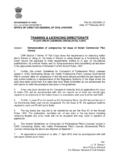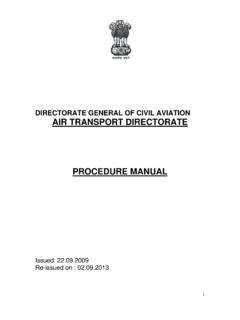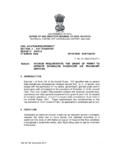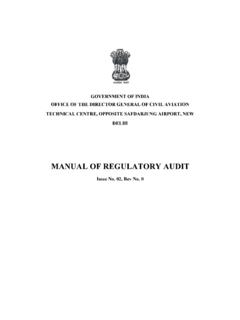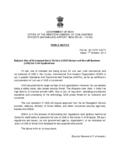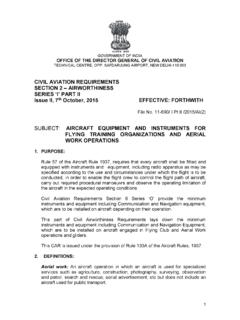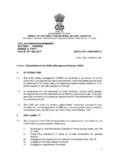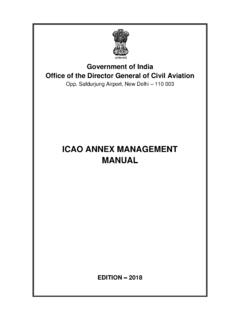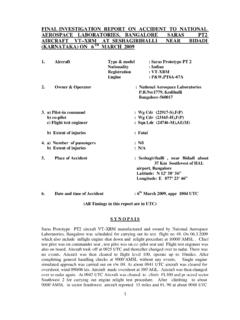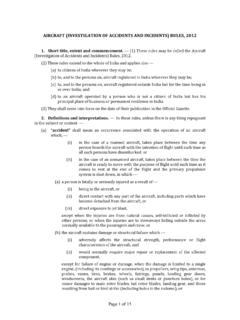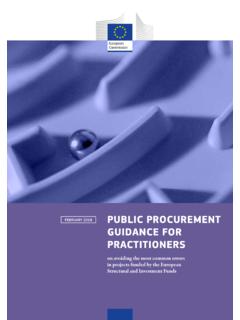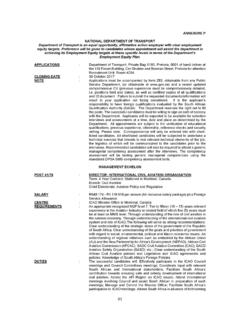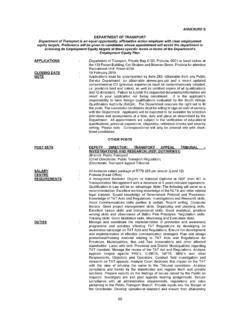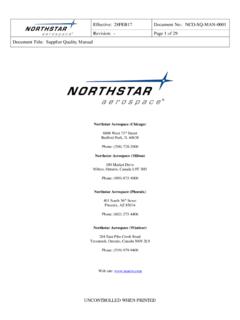Transcription of CIVIL AVIATION REQUIREMENT SECTION 7 – …
1 GOVERNMENT OF INDIA OFFICE OF THE DIRECTOR general OF CIVIL AVIATION TECHNICAL CENTRE, OPP. SAFDARJUNG AIRPORT, NEW DELHI CIVIL AVIATION REQUIREMENT SECTION 7 FLIGHT CREW STANDARDS TRAINING & LICENSING SERIES B , PART IV ISSUE- III, Dated 16th June, 2011 Effective: Forthwith F. No. CEO/Pilot Syllabus/ 2011 Subject: Syllabus for Examination for Issue of Commercial Pilot s Licence and Instrument Rating - Aeroplanes 1. INTRUDUCTION SECTION J of Schedule II of the Aircraft Rules, 1937 stipulate, amongst other requirements, that the applicant shall have to pass a written examination as per the syllabus prescribed by the DGCA for issuance of Commercial Pilot s Licence (CPL). SECTION O of Schedule II of Aircraft Rules 1937 lays down similar requirements for issue of Instrument Rating (IR) of aeroplanes.
2 This part of CAR lays down the main topics of syllabus for the written examination for issue of CPL and issue of IR in accordance with the provisions of Scheduled II. These topics of syllabus are in conformity with the knowledge requirements prescribed in ICAO Annex 1. This CAR issued under the provisions of Scheduled II and Rule 133A of the Aircraft Rules, 1937. 2. SYLLABUS Commercial Pilot s Licence (Aeroplanes) & Instrument Rating (Aeroplanes) Air Navigation The syllabus of Air Navigation is attached as Appendix A . 1 CIVIL AVIATION REQUIREMENT SECTION 7 SERIES B , PART IV 16th June, 2011 AVIATION Meteorology: The syllabus of AVIATION Meteorology is attached as Appendix B . Air Regulation: The syllabus of Air Regulation is attached as Appendix C Aircraft & Engines : The syllabus of Aircraft & Engines is attached as Appendix D.
3 Technical specific paper (concern to particular aircraft and its related system ) Technical performance Paper (Performance of the Aircraft and its Systems) Performance paper is applicable to heavy aircraft having MTOW more than 5700 kg or Twin Engine Helicopter. Radio Telephony Radio Telephony procedures and phraseology; action to be taken in case of communication failure. Signals (practical examinations) for interpretation of aural and visual signals. (E K BHARAT BHUSHAN) DIRECTOR general OF CIVIL AVIATION 2 CIVIL AVIATION REQUIREMENT SECTION 7 SERIES B , PART IV 16th June, 2011 SYLLABUS FOR COMMERCIAL PILOT LICENSE EXAMINATION - AEROPLANES 3 CIVIL AVIATION REQUIREMENT SECTION 7 SERIES B , PART IV 16th June, 2011 APPENDIX A AIR NAVIGATION 4 CIVIL AVIATION REQUIREMENT SECTION 7 SERIES B , PART IV 16th June, 2011 THE SYLLABUS OF AIR NAVIGATION IS AS FOLLOWS: 1.
4 Air Navigation a) Basics of Navigation - The solar system - seasonal and apparent movements of the sun - The earth - great circle, small circle, rhumb line - convergency, conversion angle - latitude, difference of latitude - longitude, difference of longitude - use of latitude and longitude co-ordinates to locate any specific position - Time and time conversions - apparent time - UTC - LMT - standard times - international dateline - Directions - terrestrial magnetism: declination, deviation and compass variations - magnetic poles, isogonals, relationship between true and magnetic - Distance - units of distance and height used in navigation.
5 Nautical miles, statute miles, kilometers, metres, yards and feet - conversion from one unit to another - relationship between nautical miles and minutes of latitude b) Magnetism and Compasses - general principles - terrestrial magnetism - resolution of the earth s total magnetic force into vertical and horizontal components - the effects of change of latitude on these components - directive force 5 CIVIL AVIATION REQUIREMENT SECTION 7 SERIES B , PART IV 16th June, 2011 - magnetic dip - variation - Aircraft magnetism - hard iron and vertical soft iron - the resulting magnetic fields - the variation in directive force - Change of deviation with change of latitude and with change in aircraft s heading - turning and acceleration errors - keeping magnetic materials clear of the compass - knowledge of the principles.
6 Standby and landing or main compasses and remote reading compasses - detailed knowledge of the use of these compasses - serviceability tests - advantages and disadvantages of the remote indicating compasses - adjustment and compensation of direct reading magnetic compass c) Charts - general properties of miscellaneous type of projections - Mercator - Lambert conformal conic - Polar stereographic - Transverse mercator - Oblique mercator - The representation of meridians, parallels.
7 Great circles and rhumb lines - direct Mercator - Lambert conformal conic - Polar Stereographic - The use of current aeronautical charts - plotting positions - methods of indicating scale and relief - conventional signs - measuring tracks and distances - plotting bearings 6 CIVIL AVIATION REQUIREMENT SECTION 7 SERIES B , PART IV 16th June, 2011 d) Dead Reckoning Navigation (DR) - Basics of dead reckoning - track - heading (compass, magnetic, true, grid) - wind velocity - airspeed (IAS, CAS, TAS, Mach number)
8 - ground speed - ETA - drift, wind correction angle - DR-position, fix - Use of the navigational computer - speed - time - distance - fuel consumption - conversions - heading - airspeed - wind velocity - The triangle of velocities, methods of solution for the determination of - heading - ground speed - wind velocity - track and drift angle, track error - time and distance problems - Determination of DR position - need for DR - confirmation of flight progress (mental DR)
9 - lost procedures - heading and TAS vector since last confirmed position - application of wind velocity vector - last known track and ground speed vector - assessment of accuracy of DR position - Measurement of DR elements - calculation of altitude, adjustments, corrections, errors - determination of temperature - determination of appropriate speed - determination of mach number 7 CIVIL AVIATION REQUIREMENT SECTION 7 SERIES B , PART IV 16th June, 2011 - Resolution of current DR problems by means of - mercator charts - lambert charts - polar stereographic projections - Measurement of - maximum range - radius of action - point-of-safe-return and point-of-equal-time - Miscellaneous DR uncertainties and practical means of correction e)
10 In-flight Navigation - Use of visual observations and application to in-flight navigation - Navigation in climb descent - average airspeed - average wind velocity - ground speed/distance covered during climb or descent - Navigation in cruising flight, use of fixes to revise navigation data as - ground speed revision - off-track corrections - calculation of wind speed and direction - ETA revisions - Flight log (including navigation records) 2. Mass and Balance - Aeroplanes a) Introduction to Mass and Balance - Centre of gravity (cg): Definition, importance in regard to aircraft stability (Aeroplane) - Mass and balance - consult aeroplane flight manual for: cg limits for take-off, landing, cruise configurations - maximum floor load - maximum ramp and taxi mass (Aeroplane) 8 CIVIL AVIATION REQUIREMENT SECTION 7 SERIES B , PART IV 16th June, 2011 - factors determining maximum permissible mass : structural limitations, performance limitations such as runway available for take-off and landing, weather conditions (temperature, pressure, wind, precipitation); rate-of-climb and altitude requirements for obstacle clearance.
